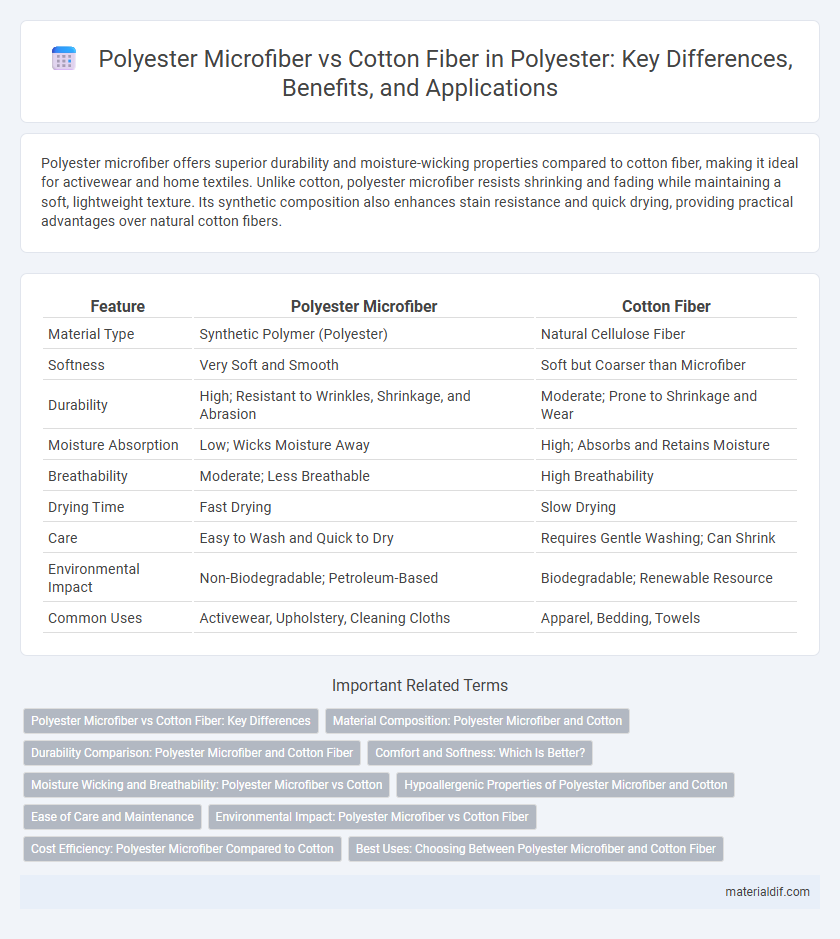Polyester microfiber offers superior durability and moisture-wicking properties compared to cotton fiber, making it ideal for activewear and home textiles. Unlike cotton, polyester microfiber resists shrinking and fading while maintaining a soft, lightweight texture. Its synthetic composition also enhances stain resistance and quick drying, providing practical advantages over natural cotton fibers.
Table of Comparison
| Feature | Polyester Microfiber | Cotton Fiber |
|---|---|---|
| Material Type | Synthetic Polymer (Polyester) | Natural Cellulose Fiber |
| Softness | Very Soft and Smooth | Soft but Coarser than Microfiber |
| Durability | High; Resistant to Wrinkles, Shrinkage, and Abrasion | Moderate; Prone to Shrinkage and Wear |
| Moisture Absorption | Low; Wicks Moisture Away | High; Absorbs and Retains Moisture |
| Breathability | Moderate; Less Breathable | High Breathability |
| Drying Time | Fast Drying | Slow Drying |
| Care | Easy to Wash and Quick to Dry | Requires Gentle Washing; Can Shrink |
| Environmental Impact | Non-Biodegradable; Petroleum-Based | Biodegradable; Renewable Resource |
| Common Uses | Activewear, Upholstery, Cleaning Cloths | Apparel, Bedding, Towels |
Polyester Microfiber vs Cotton Fiber: Key Differences
Polyester microfiber offers superior moisture-wicking properties and enhanced durability compared to cotton fiber, making it ideal for activewear and performance textiles. Unlike cotton, polyester microfiber resists shrinking and wrinkling, maintaining its shape and appearance after repeated washes. The finer fibers in polyester microfiber also provide a softer texture and increased breathability, distinguishing it from the coarser, more absorbent cotton fiber.
Material Composition: Polyester Microfiber and Cotton
Polyester microfiber consists of ultra-fine synthetic fibers made from polyethylene terephthalate (PET), offering superior durability, moisture-wicking, and resistance to shrinking compared to natural cotton fibers derived from cellulose in cotton plants. Cotton fiber is a natural protein-free cellulose-based fiber known for its breathability, softness, and biodegradability but tends to absorb moisture and wrinkles more easily. The material composition impacts performance characteristics such as texture, moisture management, and longevity, making polyester microfiber ideal for activewear and technical fabrics, while cotton remains favored for comfort and natural fiber preferences.
Durability Comparison: Polyester Microfiber and Cotton Fiber
Polyester microfiber exhibits superior durability compared to cotton fiber due to its synthetic polymer structure, which resists wear, stretching, and shrinking. Its resistance to abrasion and moisture makes it ideal for long-lasting textiles in activewear and upholstery. In contrast, cotton fiber, while breathable and comfortable, tends to weaken with repeated wash cycles and exposure to UV light, leading to faster wear and tear.
Comfort and Softness: Which Is Better?
Polyester microfiber offers superior softness and a smooth texture compared to traditional cotton fiber, making it ideal for comfort-focused textiles. Its fine fibers create a lightweight, breathable fabric that resists moisture and dries quickly, enhancing wearer comfort in active or humid conditions. Cotton fiber provides natural breathability and a cozy feel but tends to absorb moisture and may feel heavier, reducing comfort in hot or damp environments.
Moisture Wicking and Breathability: Polyester Microfiber vs Cotton
Polyester microfiber excels in moisture-wicking by rapidly drawing sweat away from the skin and allowing it to evaporate, keeping the body dry during physical activities. Cotton fiber, while breathable and soft, tends to retain moisture, leading to a damp and uncomfortable feeling when wet. The synthetic structure of polyester microfiber provides enhanced airflow and quicker drying times compared to natural cotton fiber, making it a preferred choice for activewear and performance fabrics.
Hypoallergenic Properties of Polyester Microfiber and Cotton
Polyester microfiber exhibits superior hypoallergenic properties compared to cotton fiber due to its tightly woven structure that resists dust mites, mold, and allergens. Cotton fibers, being natural and more porous, tend to absorb moisture and harbor allergens more readily, which can aggravate sensitive skin or respiratory conditions. The synthetic nature of polyester microfiber enables easier allergen resistance, making it a preferred choice in hypoallergenic bedding and apparel.
Ease of Care and Maintenance
Polyester microfiber offers superior ease of care compared to cotton fiber due to its resistance to wrinkles, shrinking, and staining, requiring minimal ironing and laundering effort. Its synthetic composition allows for quick drying and durability through multiple washes without losing shape or color. In contrast, cotton fibers typically demand more frequent washing and careful handling to prevent shrinkage and wear, increasing maintenance time and effort.
Environmental Impact: Polyester Microfiber vs Cotton Fiber
Polyester microfiber production consumes less water compared to cotton fiber cultivation, reducing strain on water resources and lowering environmental footprint. However, polyester microfiber sheds microplastics that contribute to ocean pollution, whereas cotton fiber biodegrades naturally without releasing harmful particles. Balancing durability and environmental concerns is crucial when choosing between synthetic polyester microfiber and natural cotton fiber.
Cost Efficiency: Polyester Microfiber Compared to Cotton
Polyester microfiber offers significantly higher cost efficiency compared to cotton fiber due to its lower production costs and longer lifespan, reducing the need for frequent replacements. Its synthetic nature allows for mass production at scale with less reliance on water and land resources, unlike cotton, which requires extensive agricultural inputs. The durability and stain resistance of polyester microfiber also contribute to lower maintenance expenses, making it a more economical choice for textiles and upholstery.
Best Uses: Choosing Between Polyester Microfiber and Cotton Fiber
Polyester microfiber excels in moisture-wicking, durability, and quick-drying properties, making it ideal for activewear, sportswear, and outdoor gear. Cotton fiber offers superior breathability and softness, suited for everyday clothing, bedding, and sensitive skin applications. Choosing between polyester microfiber and cotton fiber depends on the need for performance attributes versus natural comfort and breathability.
Polyester Microfiber vs Cotton Fiber Infographic

 materialdif.com
materialdif.com